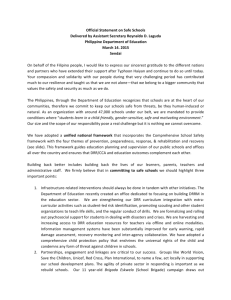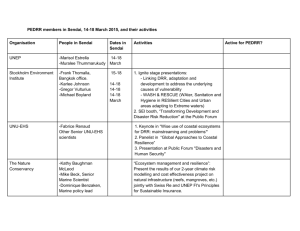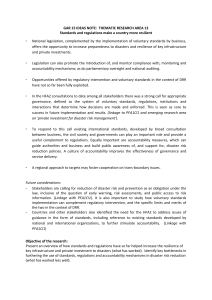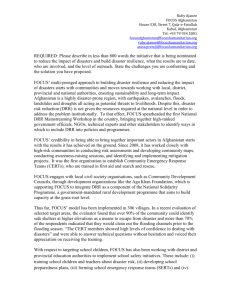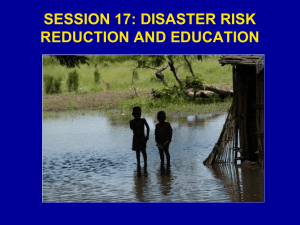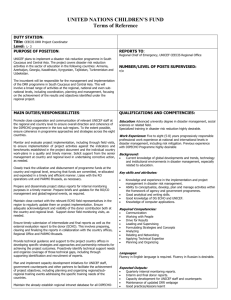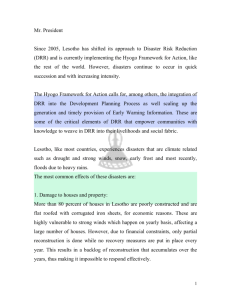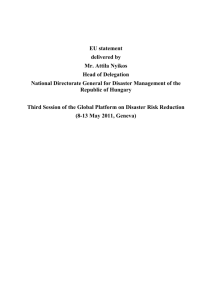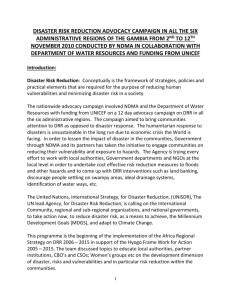Issues brief - Third UN World Conference on Disaster Risk
advertisement
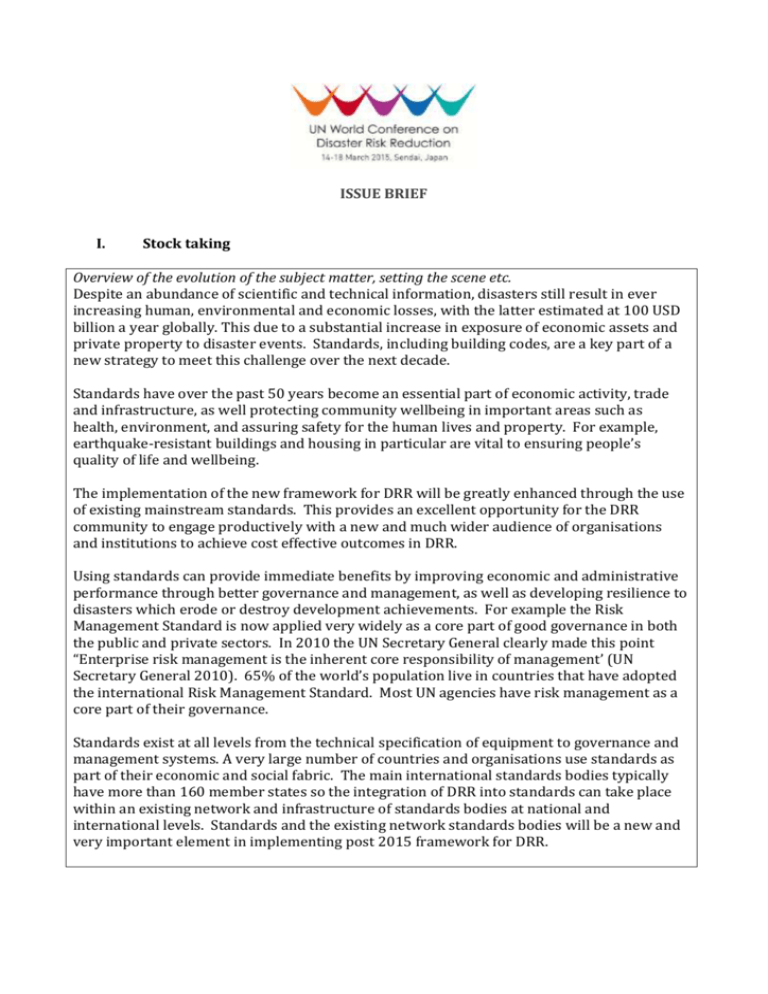
ISSUE BRIEF I. Stock taking Overview of the evolution of the subject matter, setting the scene etc. Despite an abundance of scientific and technical information, disasters still result in ever increasing human, environmental and economic losses, with the latter estimated at 100 USD billion a year globally. This due to a substantial increase in exposure of economic assets and private property to disaster events. Standards, including building codes, are a key part of a new strategy to meet this challenge over the next decade. Standards have over the past 50 years become an essential part of economic activity, trade and infrastructure, as well protecting community wellbeing in important areas such as health, environment, and assuring safety for the human lives and property. For example, earthquake-resistant buildings and housing in particular are vital to ensuring people’s quality of life and wellbeing. The implementation of the new framework for DRR will be greatly enhanced through the use of existing mainstream standards. This provides an excellent opportunity for the DRR community to engage productively with a new and much wider audience of organisations and institutions to achieve cost effective outcomes in DRR. Using standards can provide immediate benefits by improving economic and administrative performance through better governance and management, as well as developing resilience to disasters which erode or destroy development achievements. For example the Risk Management Standard is now applied very widely as a core part of good governance in both the public and private sectors. In 2010 the UN Secretary General clearly made this point “Enterprise risk management is the inherent core responsibility of management’ (UN Secretary General 2010). 65% of the world’s population live in countries that have adopted the international Risk Management Standard. Most UN agencies have risk management as a core part of their governance. Standards exist at all levels from the technical specification of equipment to governance and management systems. A very large number of countries and organisations use standards as part of their economic and social fabric. The main international standards bodies typically have more than 160 member states so the integration of DRR into standards can take place within an existing network and infrastructure of standards bodies at national and international levels. Standards and the existing network standards bodies will be a new and very important element in implementing post 2015 framework for DRR. There are two broad categories of international and national standards. Those specifically designed to deal with some aspect of disaster risk reduction, such as risk management, business continuity, mass evacuation, emergency management, organizational resilience. Those which could have DRR perspectives integrated into them. For example IEC 56 Dependability, ISO 13824:2009 Bases for design of structures which specifies general principles on risk assessment of systems involving structures. The focus is on strategic and operational decision-making related to design, assessment, maintenance and decommissioning of structures. International Standards provide a common conceptual frame and vocabulary which represents international best practice but are sufficiently flexible to allow innovation and adaption to create and implement local solutions based on the standard. Risk reduction must be both practical and reflect for local needs and culture for it to be effectively implemented. Building codes are very important to make houses, commercial establishments and factories resilient to earthquakes and extreme weather events such as storms, snow and floods. Safe housing is fundamental to community well being and development. The resilience of commercial and business establishments is critical to maintaining livelihoods and economic development. Thousands of preventable deaths each year are caused by the collapse of houses and buildings. Some countries have achieved a high level of resilience to multiple hazards by ensuring development of contemporary building codes and an effective compliance and enforcement mechanism. On the other hand, compliance with building codes remains a key challenge for governments in a significant number of countries. II. Overview Current opportunities, challenges, and achievements Standards are an essential component of governance and they enhance transparency and accountability in decision making. More than 1 million organisations worldwide including UNOPS are using and are certified against ISO 9000. This provides an outstanding opportunity for the DRR community to engage with standards bodies to include aspects of DRR into mainstream standards. Disruption and damage to business causes huge economic losses but there has been limited adoption and implementation of standards across DRR. There is now a very strong evidence base to show the importance of protecting and restarting local economies after disasters. Standards on business continuity and disaster management are essential to protect economic productivity and enhance sustainable development. Standards are of limited value unless they are an integral part of regulatory frameworks and backed up by appropriate audit and assurance. Regulatory agencies and policy-makers can undertake a number of actions to sustain and encourage the uptake of standards by business NGOs and governments. These include: Enhance the credibility of using international standards with stakeholders. International accreditation and certification schemes may bring needed confidence that international best practice is being used at the national or local level. Involving the industry and other stakeholders in DRR regulatory design to improve design and more effective implementation including building codes, design and operation of infrastructure financial regulations and business continuity. One very significant challenge is to design regulatory frame works in which to use standards and ensure that the standards and codes are actually implemented. For example the added cost for the earthquake-resistant design of buildings may be as little as 2% to 4% of total building costs. This makes it a very attractive risk reduction investment but, as mentioned above, there are still very significant problems in application and enforcement of standards and codes, such as lack of skill in seismic design, construction techniques and policy development and administration. III. Way forward Where to from here? Highlight opportunities, next steps, expectations post-Sendai. The UN Secretary General has made the point “It is my profound hope that Member States will use the risk management under the proposed framework in their strategic planning and resource allocation decision-making” (2010). The management of risk is one of the great challenges faced by every community, organization and level of government. Disaster risk is just another category of risk that has to be managed to ensure objectives are achieved. The effects of climate change will only generate more uncertainty and complexity as communities and economies try to cope with more extreme weather events and the cascades of consequences these events generate. Multisectoral integration will be an essential activity in implementing the post 2015 framework. Risk reduction relies on the whole of society approach under the leadership of government(s). Standards facilitate multi-sector integration by promoting the adoption of common risk management frameworks and common terminology. This will bring positive systemic effects and consistent approaches, across and between sectors. International standards provide guidance for national institutions and local actors to develop efficient and effective solutions to DRR which balance development needs and the reducing the potential for disasters erode development achievements. The successful implementation of the post 2015 framework will need standards that provide a common terminology and process, promote accountability and good governance. Involving national standards bodies as partners in developing or adapting standards to contribute to DRR. Existing standards and codes need to be integrated into DRR activities. This can be addressed by identifying areas in which relevant standards are missing or inadequate. Partnerships with international standards bodies to include DRR perspectives in relevant standards will be an important strategy. For example business continuity and disaster management, also safety levels between newly constructed buildings and existing buildings. Standards and codes are only valuable if they are imbedded in regulatory frameworks and backed up by assurance programs. One of the most important challenges for the next decade is to enhance the integration of standards, regulatory frameworks and assurance programs to ensure better implementation and outcomes for communities. For example there is a very good understanding of what constitutes effective building codes. The challenge is to address the gaps between building codes and buildings constructed. One important strategy is to improve the capability of building engineers in disaster resistant design and construction of structures. Codes on earthquake-resistant design and construction. are essential to reduce of damages and loss of life caused by earthquakes. Building codes should be scientifically sound, but also relevant and enforceable for governments, engineers and for people living in the region. It is very important to encourage the revision of existing codes or the development of new building codes to mitigate future losses. Experience and learning about rehabilitation and reconstruction practices at the national or local levels should be recorded, documented and shared. The review process must make them more applicable in the local context, particularly in informal human settlements, and reinforce the capacity to implement, monitor and enforce such codes, including through a consensus-based approach. Programs to address the lack of awareness of the importance of the using of national and international standards need to be developed. There is not a strong link between people working in DRR and their national and international standards institutions. Standards need to be made more accessible, through appropriate handbooks, materials and education programs. Capacity building for stakeholders such as policy makers, businesses, engineers, regulators, infrastructure builders and managers, municipalities and insurance providers is essential to the implementation of standards. Internationally consistent guidance, benchmarks and metrics can be provided by standards so that progress towards shared priorities can be measured and comparisons across different disaster risks and geographical locations can be made. Standards are fundamental to being able to demonstrate to all stakeholders accountability transparency and coherence of action to reduce disaster risk. The post 2015 Strategy will see new partnerships networks and programs for practical approaches to managing disaster risk developed to support the achievement of sustainable development goals.
